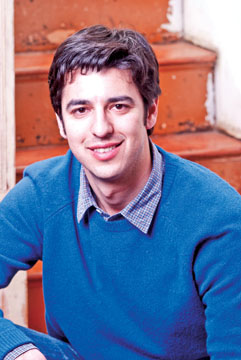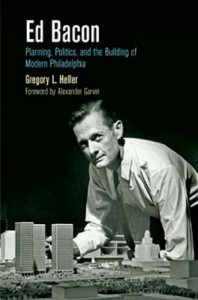BETWEEN THE LINES: CITY PLANNER AS AGENT OF CHANGE

 Ed Bacon: Planning, Politics, and the Building of Modern Philadelphia (University of Pennsylvania Press), the fascinating story of a visionary city planner by Gregory L. Heller ’04, had its genesis as a Wesleyan senior thesis.
Ed Bacon: Planning, Politics, and the Building of Modern Philadelphia (University of Pennsylvania Press), the fascinating story of a visionary city planner by Gregory L. Heller ’04, had its genesis as a Wesleyan senior thesis.
It all began in the summer of 2002, between my junior and senior years at Wesleyan. I was researching for a thesis that involved city planning in Philadelphia, and everyone told me I had to speak with Ed Bacon while he was still around. Bacon was 91 years old at the time and a local legend. As chief planner in the 1950s and 1960s, he is associated with a host of major redevelopment projects that shaped Philadelphia’s urban fabric. His face was on the cover of Time magazine in 1964.
I wrote Bacon a letter and he invited me to his home near Rittenhouse Square—a townhouse with a brick façade painted black and a sunshine yellow door. We hit it off and Ed asked me to take off a year of school and help him write a memoir. I agreed to do it. During this remarkable year, I had the opportunity to meet giants in the fields of planning and architecture like I.M. Pei. I tape recorded hours of interviews with Ed and learned all about his view of the world.
Ed Bacon was a temperamental figure, but he loved informed debate. He listened carefully and responded thoughtfully. A constant stream of students and visitors came to his door each week. There were two kinds of visitors: those who debated willingly and enthusiastically, and those who were afraid to stick up for themselves, cowered, and were promptly kicked out of the house.
Bacon’s family was welcoming. I visited their country home in Chester County, attended a few family parties and dinners. Bacon’s movie-star son took me to lunch before I started work with his dad. They were very helpful in the eventual writing of their father’s biography.
Working with Ed Bacon was quite a way to spend my gap year. I could not have traded the value of the experience for any amount of schooling or professional degrees. I went back to Wesleyan after my year with Ed and wrote a senior thesis on one of the Bacon-era projects, with the help of my extraordinary adviser, Professor Lily Milroy.
All the while I had in the back of my mind that I might end up writing Bacon’s biography. Ed passed away in October 2005, and soon thereafter a publisher asked me to write his life story. I had no idea what I was getting into, or else I might not have agreed to do it. Writing a book while holding down a day job (especially one you’re passionate about) is no simple task. It took about six years to research and write the book, involving many early mornings and late nights, lots of coffee and whiskey. It put a real cramp in my social life.
People often asked me if I was getting a PhD out of the project. Of course it would have been nice if I had, but there was something refreshing about writing a scholarly work outside the confines of the traditional academic structure. I had to figure things out for myself and entrepreneurially solve problems. Sometimes I felt like I was in over my head, and other times like everything was falling into place. The whole process felt very Wesleyan.
After a saga where the first publisher released my manuscript, another publisher, University of Pennsylvania Press, picked it up. I went through an extensive developmental editing process, and the end result was much stronger (and shorter) than the original.
Throughout the course of the project, I had an internal struggle having to do with the fact that I am not an academic or primarily a writer. I am a practitioner who spends his days developing social-impact urban real estate and innovating new approaches to economic development. I wanted the book to feel relevant to me and to all the other urban doers out there. As a pure biography it did not feel relevant; in its ultimate form it very much did.
The book that finally emerged was an amalgam of things: part biography, part case study of Philadelphia’s 1950s/1960s planning, and part narrative about the toolkit of policy entrepreneurship. I argue in the book that Bacon played the rare role of urban planner who also understood the process of politics, policy, and implementation. He was a marketer of ideas and an active player in the process of transforming ideas into reality. Many planners, architects, and designers make plans on paper that sit on a shelf for others to realize. Bacon saw it as his duty to make the plans become real.
Ed deserves a biography. He’s important in history, and his real story was largely unknown. But the point of my book is that city planners need to also be doers. It’s a story that goes far beyond city planning and Philadelphia. It’s about how a single person can truly have an influence—can actually change the world. —GREGORY HELLER
Gregory Heller is interim president and CEO of American Communities Trust, a Baltimore-based nonprofit organization. His writing on city planning has appeared in Next American City, the Philadelphia Inquirer, and Imagining Philadelphia: Edmund Bacon and the Future of the City (University of Pennsylvania Press). For more information, go to hellergreg.com.
